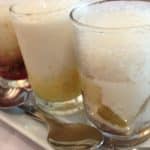Guinomis - Sago, Pinipig and Gulaman in Coconut Milk
Guinomis is a favorite Filipino chilled dessert and beverage in our home. It's similar to the ice-cold halo-halo, but with less ingredients and one I can make faster. Thanks to the Kulinarya cookbook, I was reminded of a convenient way to make guinomis for a summer afternoon snack. Whether you layer the ingredients in a small shot glass or a large parfait glass like I did, this is a Pinoy dessert that never fails to remind us of our childhood and family memories. This recipe was inspired by "Kulinarya: A Guidebook to Philippine Cuisine" (Second Edition, Anvil Publishing). Serves 2 to 4.
Servings: 2 people
Calories: 431kcal
Ingredients
- 2 pieces gulaman bars
- 4 cups water to cook gulaman
- 1/4 cup granulated sugar for gulaman
- 2 pieces palm sugar discs (panocha) or use 1 1/2 cups brown sugar
- 2 1/2 cups water to make syrup
- 4 pieces pandan leaves each tied in knots (screwpine) leaves, fresh or frozen
- 1 cup boiled sago
- 1/2 cup pinipig pounded young rice grains
- 2 cups crushed ice enough to fill 2-4 glasses
- 1 1/2 cups coconut milk canned or fresh
Instructions
- Make the gulaman: In a rectangular-sized, deep container, soak the gulaman bars with water for 30 minutes. When gulaman bars have softened, pour the water in a medium-sized stockpot. Cover and bring the water to a boil. As water is boiling, tear off pieces of the gulaman and add to the stockpot. Stir till the gulaman dissolves completely. Add sugar to gulaman. Pour the cooked gulaman in a rectangle or square container. Refrigerate for at least 40 minutes. When the gulaman hardens, cut into cubes and set aside.
- Make the syrup: combine the palm sugar discs (panocha), water and pandan leaves each tied in a knot in a medium-sized stockpot. Bring to a boil and then lower to a simmer. Stir and make sure the palm sugar is completely dissolved. The syrup will become thick and have a floral fragrance from the pandan. Turn off heat and set syrup aside.
- To assemble: In 8-ounce parfait glasses, place layers of gulaman, sago, rice pinipig, syrup. Repeat layers in the same order leaving space for the crushed ice. Add crushed iced on top. Pour about 1/8 cup of coconut milk or more into each glass over the ice.
- Serve chilled.
- Cook's Comments: I used frozen pandan leaves for this recipe. If fresh or frozen pandan are not available, I use liquid pandan flavoring to add to the syrup. If I cannot find panocha or palm sugar solid discs, I use regular palm sugar or brown sugar and the dessert is just as sweet and delightful. Sago are available in both small and large balls. They are either cooked and bottled or sold uncooked which you simply boil in water till the whites are fully gone and leaves a soft, gummy sago ball.
- Ingredient notes: Panocha or the palm sugar discs are defined by the cookbook as raw, unrefined sugar that comes in granulated form or in molded cakes.
- Kulinarya: A Guidebook to Philippine Cuisine (Expanded Second Edition, Anvil Publishing) This is one of the best Philippine cookbooks around that is a great resource for beginner home cooks or the formally-trained culinary expert. The book, through the Asia Society brings together six of the Philippine's most prominent chefs: Glenda Barretto, Claude Tayag, Conrad Calalang, Margarita Fores, Myrna Segismundo, and Jessie Sincioco with full color photographs by Neal Oshima. The renowned chefs share their talents, passion and knowledge of Philippine cuisine to provide readers a better understanding and appreciation of the culture and country through a wide range of classic recipes. The second expanded edition follows the success of the Kulinarya Guidebook. This cookbook provides the necessary information for cooking methods and great practices for Filipino Cuisine. Kulinarya is available where most cookbooks are sold and at online sources (see my Amazon affiliate line up of products used for this recipe).
- Disclosure: This cookbook was a gift from Tuttle Publishing. I was not paid to do a review or cook from it. But I will gladly recommend it as a resource for classic Filipino recipes.
- Hello, Friends! All the images and content on this blog are COPYRIGHT PROTECTED and owned by my media company Besa-Quirino LLC. This means BY LAW you are NOT allowed to copy, scrape, lift, frame, plagiarize or use my photos and recipe content I wrote, on your website,books, films, television shows or videos without my permission. If you want to republish this recipe or content on another website, video or news article,or media outlets mentioned above please ASK my permission, re-write it in your own words and simply link back to this blog to give proper attribution. It’s the legal thing to do. Thank you. Email me at [email protected]
- Disclosure: As a participant in the Amazon Affiliate program, some blog posts contain links to products used in the recipe and sold on Amazon. The price stays the same for the readers who wish to purchase these products on my links. I earn a small commission from Amazon which helps maintain the blog expenses. Thanks in advance for your support.
Nutrition
Serving: 1g | Calories: 431kcal | Carbohydrates: 30g | Protein: 3g | Fat: 36g | Saturated Fat: 32g | Sodium: 75mg | Potassium: 373mg | Sugar: 25g | Vitamin C: 1.7mg | Calcium: 62mg | Iron: 5.6mg
